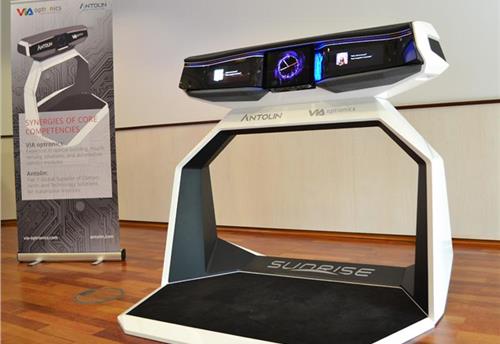ZF honours employee ideas with Invention Award 2014
ZF Friedrichshafen AG has recognized innovation effort in its workforce with a prestigious award.
ZF Friedrichshafen AG has recognized innovation effort in its workforce with a prestigious award. The technology company honours and promotes this innovativeness among its workforce every year with the Graf-von-Soden Invention Award.
This award, which was inaugurated in 2013, is to recognize previous work undertaken by developers and promote new inventions. By the end of April 2014, six new outstanding innovations received the award, selected from all the patent applications filed in the previous year.
In 2013 the global component major 2013 invested around euro 840 million (Rs 7,008 crore) in R&D, further bolstering its position as one of the world's leading technology companies in the field of driveline and chassis technology. Last year, ZF filed 708 patents, once again gaining a top-ten ranking in the German Patent and Trade Mark Office's statistics.
The ZF Invention Award is named after Alfred Graf von Soden-Fraunhofen: After the technophile aristocrat went against his parents' wishes by studying mechanical engineering, he became one of the first managing directors of the then newly founded ‘Zahnradfabrik Gesellschaft mit beschränkter Haftung’ in 1915 – and was its technical director between 1921 and 1944.
Here’s looking at the six award-winning projects:
Electric drive close to the wheel
How can electric drives be integrated into the chassis without increasing the unsprung masses to a critical extent? A three-strong team at ZF developed a drive unit comprising an electric motor and a high-ratio transmission. This unit is installed twice in the vehicle so that both rear wheels can be driven individually. Merging the drive unit with the chassis leads to installation space advantages and a low system weight. The unsprung masses are only influenced to a limited extent thanks to the intelligent positioning of the drive units within the chassis in combination with a high-speed concept.
Dry dual clutch that is easy to assemble/disassemble
Dual clutch transmissions account for an increasingly larger share of the transmission market. This is already true for passenger cars, and will soon also be the case with commercial vehicles, as the key benefit of dual clutch transmissions is the ability to change gear without tractive force interruption. One particular challenge in this respect is activating the individual clutches as precisely as possible. With the invention filed in Germany as a patent, a ZF engineer in the Commercial Vehicle Technology division has found a solution that provides a cost-effective, simple connection between the ZF actuator ConAct and the ZF dual clutch X2C. The actuating forces are transferred reliably, while ensuring simple assembly and disassembly. The invention makes the combination of the ZF products ConAct and X2C even more compelling for customers.
Torsion vibration damper with variable spring stiffness
State-of-the-art downsizing engines, which boast almost identical power output thanks to turbocharging, pose a major challenge for the driveline: Their torsional eccentricities should not be transferred to the transmission and input shaft. Torsion vibration dampers provide this decoupling in the automatic transmission's torque converter by adjusting to the respective rotational speed (speed-adaptive mass damper). A three-strong team of engineers in the ZF Car Powertrain Technology division has now developed an alternative damper concept that allows the working point to be adjusted by altering the spring stiffness. In the lower speed range, the new damper operates more efficiently and effectively than conventional dampers. The innovation offers an alternative to today's damper system with a simple technical design and fits the transmission construction kit of the 8HP.
Sensor mechanism to ascertain the position of a gear selector switch
The prerequisite for any intelligent gearshift strategy is that the software ‘knows’ the position of the gear selector switch at any given moment. Sensors provide this information. What sounds simple is critical to safety since there would be serious consequences if the vehicle electronics were to confuse, say, the drive positions ‘R’ and ‘D’ on a vehicle fitted with an automatic transmission. A two-strong team from the Electronic Systems business unit has now developed a sensor pad which features Hall sensors mounted on a movable magnetic field plate.
The invention uses the signals which the Hall sensors emit depending on the detected magnetic field. A new design makes it possible not only to determine the direction of the magnetic field but also to ascertain whether there is a magnetic field at all. Thus each Hall sensor in the sensor mechanism can be assigned three instead of the previous just two states. ZF says this design allows it to respond better to the different requirements of its customers, for instance if the level of safety is to be enhanced on certain vehicle models. The number of Hall sensors can be reduced where the level of safety remains unchanged. It also provides another simpler functional check option for Hall sensors.
New noise-reduction auxiliary valve for the CDC (Continuous Damping Control) adaptive damping system
Noise emission is becoming an increasingly important issue on modern vehicles. Even vibration dampers can contribute substantially to noise emission in the vehicle – provided that the cause and the components associated with the noise generation are known. With a conventional vibration damper there is a single damping force characteristic curve for which a vibration damper can be optimized fairly easily in terms of noise generation. This becomes much more complex with an adjustable vibration damper because here a host of controllable damping force characteristic curves come in play – in other words an entire characteristic map. Noise-reduction measures must of course not impair the function of the dampers.
With an invention, three engineers from the Chassis Technology division have found a design solution that requires no additional installation space nor any expensive components. The noise emission in an adaptive damping system can be reduced by simply moving the flow paths, coupled with a defined lifting movement of the valve disc of an auxiliary valve.
Electrically driven swashplate for a helicopter
Apart from the automotive sector, the trend of replacing hydraulic auxiliary power with electrical energy also extends to aviation applications. The Aviation Technology business unit has performed several research programs in which electric control systems for the active control of the rotor were developed. A team from the business unit has drafted and patented booster swashplate integration that can be used to control a helicopter rotor using electrical actuators rather than hydraulic positioning cylinders. This simplifies the mechanical setup, reduces maintenance costs by eliminating hydraulic parts, and improves safety by eliminating hot, inflammable hydraulic fluid.
Photograph: The winners of the Graf-von-Soden Invention Award.
RELATED ARTICLES
Marelli Talbros Chassis Systems wins Rs 1,000 crore business from European OEM
The order, to be executed over an eight-year period, is for the supply suspension arms tailored for both conventional in...
Kia launches customised NBA display themes for North American market
Display Themes is a customised service that supports a personalised vehicle experience, allowing users to customise the ...
Antolin and VIA Optronics unveil versatile vehicle cockpit concept
The Sunrise vehicle concept cockpit, which is engineered for seamless transitions between manual and autonomous driving ...





 09 May 2014
09 May 2014
 2857 Views
2857 Views





 Autocar Pro News Desk
Autocar Pro News Desk




